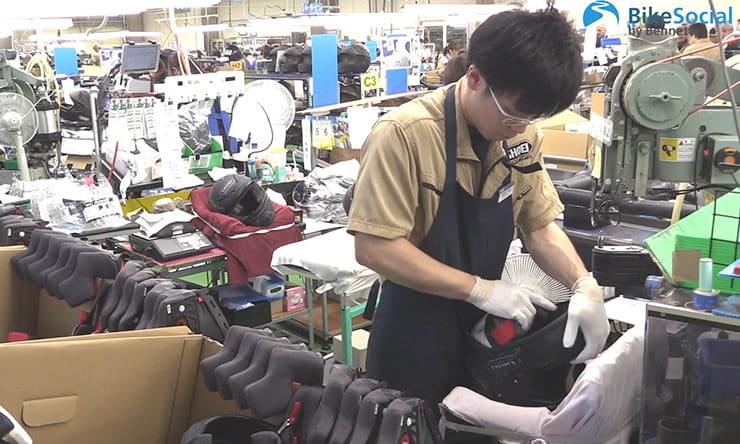How are motorcycle helmets made?
By Kane Dalton
BikeSocial's former Commercial Manager
14.06.2019
Is it just me? I’ve been wearing motorcycle helmets for a huge proportion of my life and, although I have a rough idea of how the protection works and why an expensive one costs more than a cheaper one, I would struggle to explain it clearly.
Not anymore. While we were in Japan for the Tokyo Motorcycle Show BikeSocial called in at Shoei to watch how they make their helmets. There were two big surprises; firstly, how much of the process is done by hand and secondly, just how long and how detailed the procedure is.
Here’s what we learned in a fascinating day.
How are motorcycle helmets made?
1. The shell starts out as a kit of parts.
Each shell starts out as many cut-out panels (a bit like you’d have if you were making a garment) that are carefully put together and layered by hand to build-up the correct shape with the specified thicknesses
2. There are different spec helmets for different markets.
Not all countries have the same safety standards and Shoei (along with most other manufacturers) build specific specs for specific territories. In the world of global, online marketplaces, this is important because that cheap helmet you bought online from an overseas website might not be as protective as one that looks identical bought in the UK.
3. There’s one secret part of the process
We were allowed to see how the first layered assembly is turned into the final helmet shell, but we weren’t allowed to film it or describe it. Shoei, like most of the major manufacturers are worried that their carefully-developed construction techniques could be copied by other companies. Getting the correct shell construction is a massive part of a helmet’s safety characteristics, so they guard the process carefully.
How are motorcycle helmets made? Part 1 - Factory Tour
There’s a huge amount of technology and craftsmanship in a motorcycle helmet. Shoei shows BikeSocial how it is done
4. The shell provides much more of a helmet’s protection than you’d think.
When your head hits the ground it’s a small part of the shell that touches down. For maximum safety the helmet shell has to be solid enough to resist penetration, smooth enough (helmet and vent design) to slide along the ground and soft (elastic) enough to quickly dissipate the impact force around as much of the shell as possible. By doing this it also spreads the impact force across more of the EPS (expanded polystyrene) liner as possible to minimise the force reaching a specific point of your head.
5. Achieving the perfect shell thickness
After construction a technician measures shell thickness all over the helmet and marks any areas that are too thick or thin. Then the shell is passed to another technician who adds more material in the appropriate areas.
6. The light brigade
Next up another technician shines a powerful light through the shell to look for inconsistencies in thickness. Again, all areas needing attention are marked and corrected.
7. There’s a magic roll of tape…
A special tool made out of a large roll of Sellotape is used to roll over vents and air foils when they are glued in place. It’s the perfect hand made tool; applying pressure, but not too hard that it damages the delicate parts.
All the factory staff wear white gloves, they cut the tips off the fingers that are needed for specific tasks.
8. Water Decals
All the graphics are applied by hand as water-based decals. The speed and accuracy of the artists at work here has to be seen to be believed. 14 minutes for simple designs and 45 minutes for more detailed.
9. But that’s not the end of it…
Each helmet’s graphics are carefully inspected and then touched up and finished off by hand using special paint. The top plastic layer is then polished off by hand and then the shell goes off to be lacquered in glass or matt finish.
10. All the fittings are attached by hand.
All the tiny visor screws and vent fittings are applied by hand. Only the helmet strap if attached by machine, but still by hand.
11. Final assembly is also by hand
The last three stages are fitting the EPS liner, Fitting the cheek pads and headliner and finally the visor. It’s all done in less time than it would take you or I to change the visor.
How are motorcycle helmets made? Pt 2 - Testing
There’s a huge amount of technology and craftsmanship in a motorcycle helmet. Shoei shows BikeSocial how it is done
How are motorcycle helmets tested?
12. Testing is brutal
Five helmets from every thousand are tested for impact protection and penetration resistance. Watching a helmet being dropped onto a sharp anvil from a couple of storeys up (to get the speed correct) is a graphic reminder of why we should always wear one. The visors are tested for impact resistance by firing air-gun pellets at them and Shoei has its own wind tunnel for aero and noise testing
